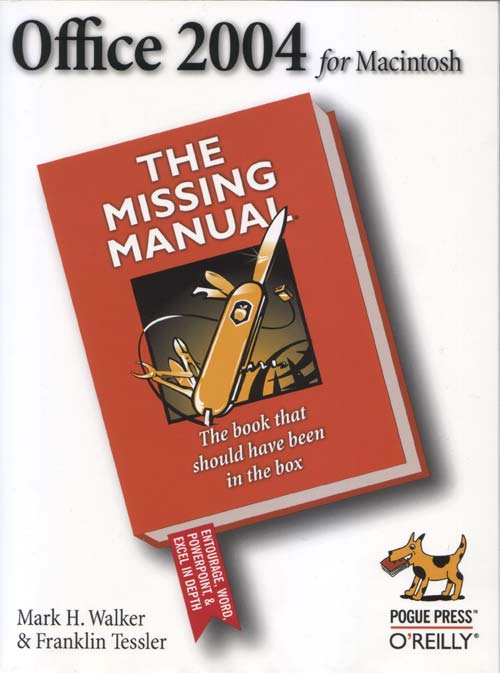



It is sobering to think that more articles, books, brochures, papers, and almost any other kind of written communication have been created in Microsoft Word than any other medium in history. Each day, people throughout the world write more pages of information in Word than we have pages of information written in the entire span of the Roman empire. It is the single most potent writing tool ever created.
Which doesn’t mean it is the best, or easiest to use. Originally released in 1983 as a text-only competitor to WordStar and WordPerfect, Word was pretty much ignored until a Mac version was released in 1984. Instead of mono-spaced letters against a blue background, the sharp bit-mapped screen of the Macintosh allowed Word to have bold type that was actually bold, italics that were actually italicized, and fonts in wild and wonderful profusion.
Since that time, the Mac has seen a number of superb word processors come and go -- Word’s predecessor MacWrite, followed by WriteNow, FullWrite, MacWrite II, WordPerfect, AppleWorks, and countless others -- but Microsoft Word, much enhanced and evolved over two decades -- has endured. What once fit on a couple 400K floppy discs now requires a CD-ROM disc. What once came with an entire mini-library of manuals now comes with, to be honest, nothing at all. If you don’t know how to use Word 2004, you probably will never discover the electronic documentation, and no manual is included to help you overcome your ignorance.
Adding to the strain, Word is usually not packaged alone, but sold in a bundle with Excel and PowerPoint as Microsoft Office. Excel, introduced in 1985, is a spreadsheet, designed to slice and dice numbers in all manner of interesting ways, yet it is so little understood that, twenty years after its introduction, most users apply it to creating rows and columns of gridded text. They have no clue how to make it add, subtract, multiply or divide, much less create pie charts and bar charts, and Excel 2004 comes with no manual to guide them out of darkness.
PowerPoint, purchased by Microsoft and thrown into the Microsoft Office bundle as a means of destroying American productivity, is a presentation package. With it, you can create “slides,” reducing any problem to simplistic bullet points on a page. No manual or hazardous materials warnings are provided with PowerPoint 2004. Significantly, PowerPoint is incredibly popular inside the Beltway, which explains so much...

Into this void step Mark Walker and Franklin Tessler with their Office 2004 for Macintosh: The Missing Manual. It is a shockingly well done guide to this complex collection of applications. Given the hundreds of books that have been written on Office and its various parts over the years, this is a major feat. Word, Excel, and PowerPoint are each covered individually, along with Entourage (a combination E-mail client, news reader, address book, note pad, calendar, Palm synchronizer and compact fishing skiff), as well as chapters on using the applications in concert with one another.
While there are some narrative passages that review general concepts, most of the book is devoted to heavily illustrated task-oriented topics. Sidebars cover remedial topics, advanced topics, hints and tips, alternative ways of doing something, and “oh no how do I fix that?” issues. The authors are quite kind to Microsoft, which may disappoint those who see Redmond as the home of the Dark Lord, but do suggest, for example, that while you can open a Web page with Word 2004, you shouldn’t, and while you can export a Word document in HTML format, you shouldn’t do so unless you are desperate.
Many veteran Office users have a love-hate relationship with the package. The most common complaint is: Word (or Excel) inserts, rewrites, corrects, or otherwise changes what the user types. This can lead some users to extreme expressions of distress, not suitable for broadcast on television or repetition at church. Mercifully, the authors devote considerable attention to this topic (look for “AutoFormat” in the index).
The weakest part of the book is the section devoted to PowerPoint. Many PowerPoint users, for example, have trouble figuring out how to use templates (called “Slide Master” in PowerPointese). While the book does cover the topic decently, those who have trouble will probably still have trouble after reading the book. This is both a reflection on PowerPoint itself -- an epically poor program -- as well as an evident lack of interest on the part of the authors. They clearly like Word and Excel; no such warmth is evident towards PowerPoint.
As a guide to Office, this volume is highly recommended. The world’s most powerful communications package needs an operator’s manual, and this volume serves that purpose admirably.
Mark H. Walker and Franklin Tessler, Office 2004 for Macintosh: The Missing Manual. O’Reilly, 2005. xii, 736 pp. ISBN 0-596-00820-1. $29.95